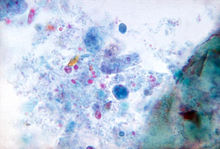Dientamoeba
| Dientamoeba fragilis | |
|---|---|
 |
|
| Scientific classification | |
| Domain: | Eukaryota |
| (unranked): | Excavata |
| Phylum: | Metamonada |
| Class: | Parabasalia |
| Order: | Trichomonadida |
| Family: | Monocercomonadidae |
| Genus: | Dientamoeba |
| Species: | D. fragilis |
| Binomial name | |
|
Dientamoeba fragilis Jeeps et Dobell, 1918 |
|
Dientamoeba fragilis is a species of single-celled excavates found in the gastrointestinal tract of some humans, pigs and gorillas. It causes gastrointestinal upset in some people, but not in others. It is an important cause of travellers diarrhoea, chronic diarrhoea, fatigue and, in children, failure to thrive. Despite this, its role as a "commensal, pathobiont, or pathogen" is still debated.D. fragilis is one of the smaller parasites that are able to live in the human intestine. Dientamoeba fragilis are able to survive and move in fresh feces; however are sensitive to aerobic environments. They dissociate when in contact or placed in saline, tap water or distilled water.
It was first described in 1918.
There is a continuous debate where D. fragilis is considered to be a harmless organism or a pathogenic parasite. Infection with D. fragilis, called dientamoebiasis, is associated variously with symptoms of abdominal pain, diarrhea, weight loss, nausea, fatigue and fever. In one study, D. fragilis was identified in 0.9% of patients observed. Its coincidence with enterobiasis, caused by E. vermicularis, has been reported. In another study, eosinophilia was present in half of the infected children participating in the case.D. fragilis does not penetrate the host tissue directly; therefore, some of these symptoms may be caused from irritation which then leads to colonic motility. Infection can occur at any age; however, the most common ages that have been reported are children 5-10 years old.
In order to diagnose the parasite, patients are required to provide (multiple) fresh stool samples that have been preserved for parasite examination. The multiple samples are required because of parasite detection being difficult, therefore, a sample might be obtained each day to help increase the sensitivity. Patients can also be tested for E. vermicularis since the two parasites are known to coincide.
Once diagnosed, E. vermicularis is also searched throughout the body. Depending on the age and clinical status of the patient will determine the treatment given. If the patient is a child, a temporary treatment would be offered to test if symptoms can be alleviated, otherwise, another diagnosis and treatment are required. If the child is asymptomatic, then treatment is not necessary. Iodoquinol is the primary drug treatment for dientamoebiasis, unfortunately there are side effects such as abdominal cramping, nausea and rash. There are other medications that treat dientamoebiasis, including paromomyacin, and metronidazole. Tetracycline and doxycycline have also been used as a form of treatment. Drugs such as secnidazole and ornidazole have been used as well, but are not available in the United States.
...
Wikipedia
